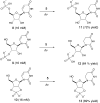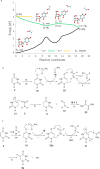Prebiotic synthesis of dihydrouridine by photoreduction of uridine in formamide
- PMID: 38896044
- PMCID: PMC11223185
- DOI: 10.1039/d4cc01823k
Prebiotic synthesis of dihydrouridine by photoreduction of uridine in formamide
Abstract
In this report, we show that a very common modification (especially in tRNA), dihydrouridine, was efficiently produced by photoreduction of the canonical pyrimidine ribonucleoside, uridine in formamide. Formamide not only acts as a solvent in this reaction, but also as the reductant. The other three components of the canonical alphabet (C, A, G) remained intact under the same conditions, suggesting that dihydrouridine might have coexisted with all four canonical RNA nucleosides (C, U, A, G) at the dawn of life.
Conflict of interest statement
The authors declare no conflicts of interest.
Figures




Similar articles
-
Selective prebiotic formation of RNA pyrimidine and DNA purine nucleosides.Nature. 2020 Jun;582(7810):60-66. doi: 10.1038/s41586-020-2330-9. Epub 2020 Jun 3. Nature. 2020. PMID: 32494078 Free PMC article.
-
Preparation of short interfering RNA containing the modified nucleosides 2-thiouridine, pseudouridine, or dihydrouridine.Curr Protoc Nucleic Acid Chem. 2009 Jun;Chapter 16:16.2.1-16.2.16. doi: 10.1002/0471142700.nc1602s37. Curr Protoc Nucleic Acid Chem. 2009. PMID: 19488969
-
Meteorite-catalyzed syntheses of nucleosides and of other prebiotic compounds from formamide under proton irradiation.Proc Natl Acad Sci U S A. 2015 May 26;112(21):E2746-55. doi: 10.1073/pnas.1422225112. Epub 2015 Apr 13. Proc Natl Acad Sci U S A. 2015. PMID: 25870268 Free PMC article.
-
Prebiotic Organic Chemistry of Formamide and the Origin of Life in Planetary Conditions: What We Know and What Is the Future.Int J Mol Sci. 2021 Jan 18;22(2):917. doi: 10.3390/ijms22020917. Int J Mol Sci. 2021. PMID: 33477625 Free PMC article. Review.
-
Formamide chemistry and the origin of informational polymers.Chem Biodivers. 2007 Apr;4(4):694-720. doi: 10.1002/cbdv.200790059. Chem Biodivers. 2007. PMID: 17443884 Review.
References
MeSH terms
Substances
LinkOut - more resources
Full Text Sources

